Oriental rugs are one of the most popular types of rugs in the world. They have rich colors, intricate patterns, and high quality. But what exactly are oriental rugs?
Oriental rugs are heavy textiles for various purposes. They come from “Oriental countries” and people use them at home, sell them locally, or export them.
Oriental carpets can have pile or no pile. They use different materials such as silk, wool, cotton, jute, and animal hair.
Geographically, oriental rugs are made in an area called the “Rug Belt.” It goes from Morocco across North Africa, the Middle East, and into Central Asia and northern India. It includes countries like northern China, Tibet, Turkey, Iran, the Maghreb in the west, the Caucasus in the north, and India and Pakistan in the south.
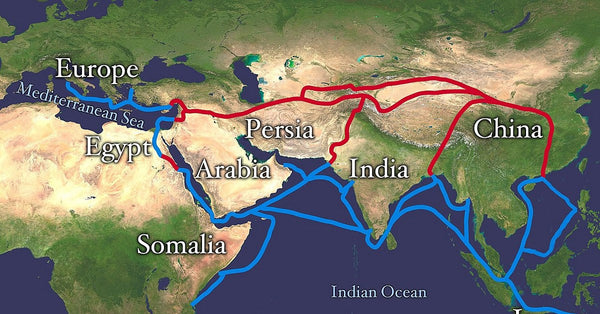
Map of the Silk Road, for the Period 500 BCE to 500 CE
The History of Oriental Rugs
The History of Oriental Rugs Oriental rugs have a long and rich history that goes back to thousands of years ago. The earliest evidence of oriental rugs is from ancient Persia (now Iran). There, they were used as floor coverings, wall hangings, and ceremonial objects. Oriental rugs were also traded along the Silk Road. It was a network of routes that connected Asia with Europe and Africa. Royalty, nobility, and wealthy merchants valued oriental rugs for their craftsmanship and beauty. The art of making oriental rugs reached its peak during the Safavid dynasty (1501-1736) in Iran. Master weavers created exquisite carpets with complex designs and vibrant colors. Some of the most famous oriental rugs from this period are the Ardabil Carpet, the Coronation Carpet, and the Hunting Carpet. These carpets are now in museums around the world as examples of fine art.
The influence of oriental rugs spread to other countries in Asia, such as Turkey, India, China, and Afghanistan. Local weavers adapted their own styles and techniques to create unique rugs. For example, Turkish rugs have geometric patterns and bold colors; Indian rugs have floral motifs and fine details; Chinese rugs have symbolic designs and soft colors; and Afghan rugs have tribal patterns and rustic charm. Oriental rugs have also inspired many artists and designers in the West, such as William Morris, Frank Lloyd Wright, Pablo Picasso, and Andy Warhol. Oriental rugs are a symbol of culture, art, and luxury in many homes around the world.

Pazyryk rug, Circa 400 BC, Hermitage Museum, Russia
Types of Oriental Rugs by Region
Oriental rugs can be classified by their region of origin. These regions represent different strands of tradition. They include Persian rugs, Pakistani rugs, Arabian rugs, Anatolian rugs, Kurdish rugs, Caucasian rugs, Moroccan rugs, Turkestanian (Turkmen, Turkoman) rugs, and Indian rugs.
Persian (Iranian) Rugs
Persian rugs are the most famous and diverse type of oriental rugs. They are an integral and distinguished part of Persian culture and art. They date back to ancient Persia. Persian carpets are categorized based on where they were woven (nomads, villages, towns), who made them (e.g., Kurds, tribes like Khamseh, Azerbaijani, Turkmens), or their regions, such as Hamadan, Senneh, Bidjar, Sarouk, Kashan, and Qom.
Read more about Persian Rug Types

1900s Persian Afshar Rug, Rug the Rock Collection
Anatolian (Turkish) Rugs
Turkish carpets mainly come from Anatolia and neighboring areas. Carpet weaving is an ancient art in Anatolia that integrates different cultural traditions. It reflects the history of the Turkish people. Different types of carpets were woven in workshops, provincial facilities, villages, tribal settlements, or by nomads.
The Turkish carpet stands out from other carpets due to its use of primary colors. It also features bold geometric designs and stylized floral patterns. They are generally arranged in a rectilinear design.
They come from various regions in Turkey, each with its own style. Some of the popular Turkish rug styles are Ushak , Hereke , Kayseri (or Kayseri), Bergama, Konya , Milas.
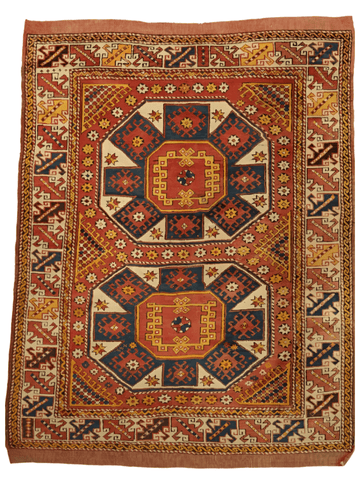
1930s Turkish Çanakkale Rug, Rug the Rock Collection
Egyptian Mamluk Rugs
The Mamluk Sultanate in Egypt produced a distinctive carpet in Egypt, which came to be known as “Damascene” carpets in previous centuries. Researchers have now established that Cairo was the center of production for these carpets. Two different cultures merged after the Ottoman conquest of the Mamluk Sultanate in Egypt in 1517. This resulted in a unique style observed in the Mamluk carpets woven during and after this period.
Caucasian Rugs
The northern territories of the Safavid Empire of Persia comprised Karabagh, Moghan, Shirvan, Daghestan, and Georgia. Russia gained these provinces through the Treaty of Constantinople in 1724 and the Treaty of Gulistan in 1813. Russian rule also extended to Baku, Genje, the Derbent khanate, and the Talish region.
Shah Abbas I of Persia established carpet manufactories in Shirvan and Karabagh at the beginning of the seventeenth century. The carpet weavers in the Caucasus region adopted Safavid field divisions and floral motifs but modified their style according to their ancient traditions. Characteristic motifs include stylized Chinese dragons in the so-called “Dragon carpets,” combat scenes depicting tigers and stags, or floral patterns. The style is highly abstract to the extent that animal forms become unrecognizable. Among the most popular groups of Caucasian rugs are the "Kazak" carpets.
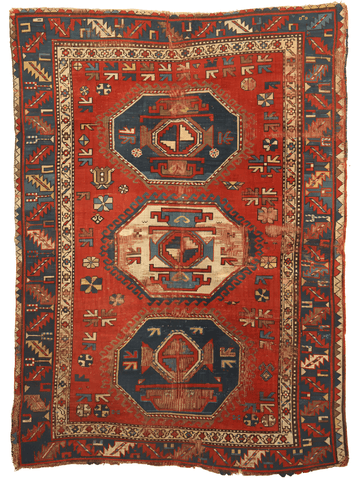
19th Century Caucasian Karachov Kazak Rug, Rug the Rock Collection
Turkmen Rugs
The Turkmen tribes lived near the borders of modern-day Iran and Afghanistan, where they made rugs and smaller items. They preserved much of their traditional culture, as they were less amenable to assimilation than their neighbors. The history of the Turkmen tribes is characterized by migrations, alliances, intertribal warfare, and even the violent extinction of regional populations. Knowing both the history of a Turkmen tribe and its migrations, as well as the characteristics of their structure and design, helps to attribute a rug or pile-woven household item to a certain tribe and a certain period in its history.
Madder red is the main color in nearly all Turkmen rugs. They obtained it locally and used it to dye in various shades.
Commercialization led to the production of carpets for export in Pakistan and Afghanistan. They are known as “Bokhara rugs” in trade and have designs inspired by Turkmen carpets. However, the colors and the quality of design did not match the original.

1970s Turkmen Rug, Rug the Rock Collection
Indian and Pakistani rugs
India and Pakistan, two countries that separated in 1947 during the Partition of India, have a rich history of rug weaving. Rug weaving has been known in India since at least the sixteenth century. The original models were likely Persian, as their designs appear closely related. Moreover, other influences from central Asia also played a role, but India soon developed its own distinctive style. People sometimes label these rugs as “Indo-Persian” due to their similarities with Persian carpet designs.
The Mughal Empire declined by the late nineteenth century, and so did carpet weaving in India. Therefore, the British colonial administration decided to establish factories, sometimes even in jails, to produce carpets for export. Even after their separation and independence, both India and Pakistan continue to engage in carpet weaving. Nowadays, carpet production in India and Pakistan frequently involves the use of foreign designs or design copies, resulting in the production of commercial rugs primarily valued for their utilitarian purposes.
Moroccan Rugs
Moroccan Rugs have a rich history that dates back to ancient times. The Berber people, who are the indigenous inhabitants of North Africa, created these rugs first. They used natural materials such as wool, camel hair, and silk to make rugs that were practical and beautiful.
The Berber people have a strong connection to nature, a nomadic lifestyle, and a deep sense of community. They believe that everything in nature has a spirit, and that their rugs have the spirits of the animals, plants, and landscapes from which they are made. For them, rugs are not just objects of beauty, but also sources of protection, warmth, and comfort.
Read more about Moroccan Rug Types
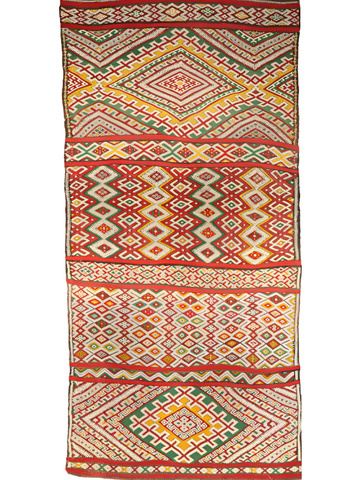
1980s Moroccan Marmoucha Soumak, Rug the Rock Collection
Afghan Rugs
Afghan rugs are a type of handwoven floor-covering textile that Afghan Turkmens and Uzbeks make in the northern and western areas of Afghanistan. They are known for their quality, durability, and distinctive designs and patterns. Some of the common motifs are elephants, octagons, flowers, and military equipment. Afghan rugs are usually made with natural dyes and Persian knots.
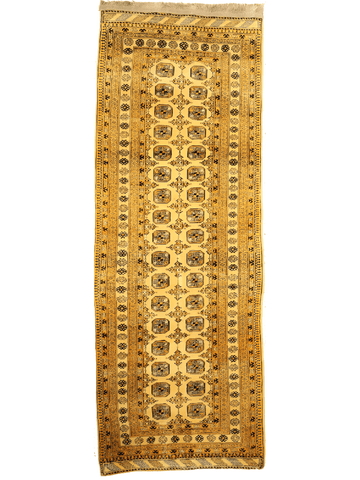
1960s Afghan Bokhara Runner Rug, Rug the Rock Collection
In this article, we learned about the different types of oriental rugs that various regions of Asia produce, such as Persia, Turkey, Morocco, and Afghanistan. We explored the characteristics, styles, and influences of each type of oriental rug, and how they reflect the culture and history of their makers. Oriental rugs are not only beautiful and durable floor-coverings, but also valuable pieces of art that can enhance any home decor with their unique charm and elegance. They also represent the diversity and richness of the oriental world, and the creativity and skill of the oriental weavers. Oriental rugs are more than just carpets; they are expressions of identity, heritage, and tradition. Hope you enjoyed!


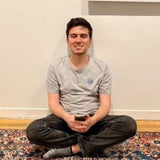













































Leave a comment